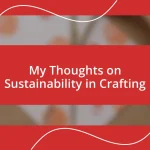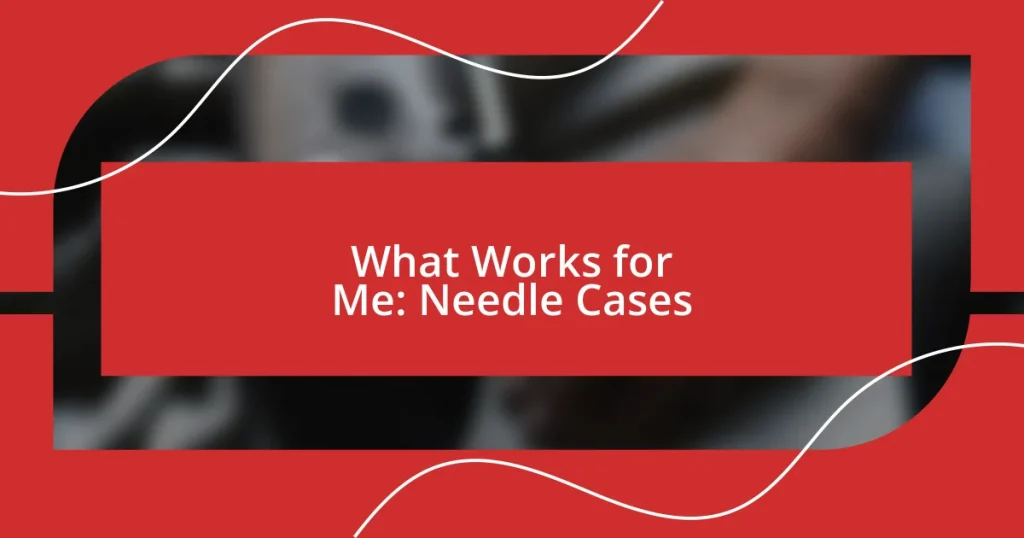Key takeaways:
- Supporting local artists enriches communities by preserving unique cultural narratives and fostering connections through creativity and craftsmanship.
- Promoting fiber artists strengthens local economies, encourages cultural preservation, and empowers artists by providing them visibility and recognition.
- Effective marketing strategies, such as storytelling and community engagement events, enhance the appreciation and understanding of fiber art, transforming consumers into advocates.

Importance of Supporting Local Artists
Supporting local artists is crucial because they infuse our communities with unique perspectives and creativity. I remember attending a local craft fair and stumbling upon a fiber artist whose work conveyed stories of her upbringing. It made me wonder—how many of us are missing out on these powerful narratives simply because we overlook the talent in our own backyards?
Investing in local artists fosters a sense of community and belonging. When I bought a handwoven scarf from a nearby artisan, it felt more than just a purchase; it was a connection to the person behind the craft. Don’t you think that when we support local creators, we contribute to a vibrant culture that nurtures individuality and passion?
Moreover, supporting local artists ensures that their skills and craftsmanship are preserved for future generations. It’s heartbreaking to think that unique techniques and stories might fade away if we don’t actively uplift those who carry them. Have you ever thought about how your choices can help keep art forms alive? By embracing local talent, we play a role in sustaining artistic expression that reflects our collective identity.

Overview of Fiber Arts Scene
The fiber arts scene is a rich tapestry of creativity, where local artisans pour their hearts and souls into each piece. I’ve often marveled at the intricate textures and colors that emerge from their hands—it’s like watching a story unfold, thread by thread. It’s striking how vibrant and diverse this community can be, often showcasing not just traditional techniques but also innovative approaches that push the boundaries of what fiber art can be.
When attending local exhibitions, I find myself enchanted by the personal stories that each artist shares about their journey. One particular artist I met had transformed a family heirloom into stunning woven pieces, effectively bridging past and present. This experience highlighted for me the emotional depth that fiber artistry can embody—it’s not just about creating something beautiful; it’s about weaving personal histories into the fabric of our community.
In a world dominated by mass-produced goods, the fiber arts scene offers a breath of fresh air. The connections formed with local artists are invaluable. I remember helping a local wool spinner with her booth at a farmers’ market, and the pride she took in her craft was palpable. Each handmade item was a representation of her passion, and I realized that by engaging with these artists, we’re not merely consumers—we’re supporters of a living art form.
| Aspect | Description |
|---|---|
| Artistry | Local fiber artists combine traditional techniques with modern innovation, producing unique and captivating work. |
| Community Impact | Support for local fiber artists strengthens community ties and fosters a rich cultural atmosphere. |
| Personal Stories | Many artists infuse their cultural heritage and personal experiences into their pieces, creating meaningful connections. |

Benefits of Promoting Fiber Artists
Promoting fiber artists offers immense benefits to both the artists and the community. Personally, I’ve discovered that supporting these creators can lead to a deeper appreciation for the craft itself. I once attended a fiber arts workshop where I learned to spin yarn, and the experience transformed my understanding of the labor and dedication behind each handmade piece. This hands-on engagement not only deepened my respect for the art form but also created lasting connections with others who share similar passions.
- Economic Growth: By promoting local fiber artists, we stimulate the local economy, encouraging more people to explore handmade goods.
- Cultural Preservation: Each piece from a fiber artist tells a story, preserving the cultural heritage and techniques that define our communities.
- Empowerment and Recognition: Supporting fiber artists gives them a platform, empowering voices that might otherwise remain unheard.
I’ve also noted that the emotional impact of fiber artistry can be profound. Visiting a local artist’s studio, I was struck by the intimate atmosphere filled with fibers in various states of creation. The artist shared how her work reflects personal struggles and triumphs, weaving her life experiences into every strand. These moments remind us that buying a scarf or a blanket is not just about the item; it’s about honoring the journey of the artist and the stories that are lovingly crafted into each work.
- Connection to Heritage: Many fiber artists draw inspiration from their cultures, weaving traditional techniques into modern expressions.
- Community Education: Workshops and demonstrations help educate the public about the importance of these crafts, fostering appreciation and understanding.
- Emotional Resonate: The stories behind the art can evoke personal reflections, making each piece a conversation starter within the community.

Strategies for Marketing Fiber Art
Marketing fiber art isn’t just about selling; it’s about storytelling. One strategy that has always resonated with me is using social media to connect the artist’s narrative with potential buyers. I remember scrolling through an Instagram account of a local weaver whose posts detailed her creative process and the emotions behind her work. Each post felt like a mini-journey, drawing me closer to her art and igniting a desire to own a piece that whispered her story.
Another approach that has proven effective is hosting community events that emphasize immersion in fiber arts. I’ve been part of a charming local fair where artisans showcased their work alongside interactive workshops. Watching attendees jubilantly try their hand at spinning yarn or dyeing fibers—much like my own first experience—created a buzz and fostered a sense of connection. This hands-on involvement is powerful; it makes the art tangible and memorable, encouraging people to invest emotionally and financially in what they’ve experienced.
Collaborating with influencers or local businesses can broaden the reach for fiber artists as well. There was this delightful collaboration I observed between a fiber artist and a nearby café; they hosted a “fiber-themed” brunch where customers could admire and even purchase local art. It transformed the café into a vibrant gallery for a day, creating an engaging atmosphere. The underlying question here is, how can we craft memorable experiences that highlight the artistry of our local creators? By thinking outside the box and fostering partnerships, we can truly elevate the profile of fiber arts within our communities.

Creating Community Engagement Opportunities
Creating community engagement opportunities around local fiber artists can be as enriching as the art itself. I still remember the first time I participated in a community fiber festival. The atmosphere buzzed with excitement, as families gathered to watch live demonstrations, try their hands at weaving, and even engage in friendly craft competitions. Those moments not only brought us all together but also sparked my curiosity about different techniques and the stories behind each creation. How often do we get a chance to enter the world of an artist and feel their passion firsthand?
Another idea I’ve found effective is organizing “meet the artist” events at local galleries or shops. I once attended a small gathering where a talented fiber artist shared her creative journey over warm tea and pastries. The conversation flowed effortlessly, and I felt a connection not just to her artwork, but to her experiences and inspirations. It made me think: wouldn’t it be wonderful if we could create more spaces for these meaningful dialogues? By directly connecting creators and the community, we transform mere buyers into advocates for the craft.
Finally, consider establishing community art projects that involve the collective effort of local fiber artists and residents. I joined a mural project where each participant contributed hand-knitted squares to form a massive tapestry. It was astonishing to see strangers come together, with everyone excitedly sharing their stories while working collaboratively. This experience taught me that art can unite us and reveal our shared narratives. How might we weave such initiatives into our community fabric in the future?

Showcasing Fiber Art Successfully
Showcasing fiber art successfully requires a blend of visibility and storytelling. I recall visiting a local gallery where each piece of fiber art was accompanied by a handwritten note from the artist. These notes provided insight into the creative process and emotional journey behind the artwork. This connection transformed my viewing experience from passive appreciation to an active understanding of the artist’s vision. Have you ever felt a deeper connection to art when you know the story behind it?
I’ve also found that vibrant display and curation matter greatly in showcasing fiber art. One time, I attended an exhibition where the artist arranged her pieces within a cozy, home-like setting, draped with textured fabrics and cushions. It felt inviting and intimate, allowing me to envision the art within my own space. This simple yet effective approach made me feel more inclined to inquire about purchasing a piece. How can we create a welcoming environment that encourages potential buyers to linger and connect with the art?
Another impactful strategy I’ve experienced is integrating demonstrations into exhibitions. At a recent fiber art show, the artist worked on lace-making throughout the event. As I watched her deft hands transform simple thread into intricate designs, I couldn’t help but ask questions. This live demonstration was not just visually stimulating; it sparked conversations and fostered a sense of community among attendees. What might happen if more artists brought their processes into the spotlight, allowing viewers to witness the artistry in action?















